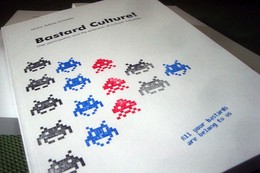M. T. Schäfer: Bastard Culture! User participation and the Extension of Cultural Industries
Filed under thesis | Tags: · participation

The computer and particularly the Internet have been represented as enabling technologies, turning consumers into users and users into producers. The unfolding online cultural production by users has been framed enthusiastically as participatory culture. But while many studies of user activities and the use of the Internet tend to romanticize emerging media practices, my dissertation steps beyond the usual framework and analyzes user participation in the context of accompanying popular and scholarly discourse, as well as the material aspects of design, and their relation to the practices of design and appropriation. I argue that participatory culture is rather a dynamic interaction of users and companies, discourses and technologies. The availability of computers and Internet expand the traditional culture industry into the domain of users, who actively participate in cultural production, either by appropriating products from the commercial domain or by creating their owns. But while user activities constitute a significant loss of control for certain sectors of traditional media industries, especially in the area of distribution, the larger culture industry benefits from user driven innovation through the appropriation of corporate design. Furthermore, the media industry undergoes a shift from creating content to providing platforms for user driven social interactions and user-generated content. In this extended culture industry participation unfolds not only in the cocreation of media content and software-based products, but also in the development and defense of distinctive media practices that represent a sociopolitical understanding of new technologies.
Comment (0)Tomáš Řiháček: Zvukové prostředí města a jeho vliv na prožívání (2007)
Filed under thesis | Tags: · czech, sound recording, urbanism
Práce se zabývá otázkou, jak zvukové prostředí města ovlivňuje prožívání jeho obyvatel. Vychází především z tzv. tradice sonosféry, avšak čerpá i z tzv. hlukové tradice. Sluchová percepce je zde pojímána nikoli izolovaně, ale v kontextu interakce s reálným prostředím, v kontextu tělesnosti a každodenních aktivit. Předkládaný výzkum se pokouší z fenomenologické perspektivy zachytit prožitkové významy spojené se zvukovým prostředím města. Výzkum, který lze stručně charakterizovat jako terénní, kvalitativní a explorativní, je rozvržen do dvou fází. Během první fáze byla vytvořena pracovní typologie zvukových prostředí centra města Brna, zahrnující kategorie: dopravní uzly MHD, ulice/náměstí s hustou dopravou, ulice/náměstí s mírnou dopravou, frekventované ulice/náměstí v pěší zóně, tiché ulice/náměstí v pěší zóně, otevřená prostranství (se třemi podkategoriemi: městské sady a parky, přítomnost zeleně s blízkostí dopravy a místa s minimem zeleně a blízkostí dopravy) a atypická místa (místa se specifickým, ale ojediněle se vyskytujícím zvukovým prostředím). Druhým výstupem této fáze je seznam dimenzí zvukového prostředí relevantních z hlediska běžných obyvatel. Třetím výstupem je klasifikace a frekvenční analýza zvukových zdrojů spontánně zmíněných v popisech. Klasifikace zdrojů obsahuje sedm hlavních kategorií: přírodní zvuky, bezprostřední projevy lidí, hudební zvuky, elektronické a jiné signály, nízkoinformační technické zvuky, nerozlišený celek a ticho. Druhá, ústřední, fáze výzkumu je zaměřena na analýzu prožitků udávaných během reálné přítomnosti na vybraných místech v centru města Brna, reprezentujících jednotlivé kategorie pracovní typologie vytvořené v předchozí fázi. Jako metoda sběru dat sloužila původně psychoterapeutická technika focusing, která byla modifikována tak, aby podporovala uvědomění si a verbální uchopení spontánně se vynořujících tělesně zakotvených významů, které vznikají v kontaktu se zvukovým prostředím. Data byla analyzována podle metody zakotvené teorie a poskytla několik významných výsledků. Prvním výsledkem je deskriptivní model sonosféry (zvukového prostředí konkrétního místa), tvořený čtyřmi komponentami: dominantou, popředím, horizontem a prostorem. Dalším výstupem je seznam 35 prožitkových kategorií, uspořádaný do sedmi skupin či polarit: (1) skupina kategorií, u nichž dominuje dimenze uvolnění–excitace, (2) bezpečí–ohrožení, (3) volnost–stísněnost, (4) kontakt se sebou–rušení tohoto kontaktu, (5) osobní distance, (6) zaujetí–nezájem a (7) podporující–rušivé. Kromě prožitkových kategorií byly sledovány a analyzovány také další kategorie, týkající se jedince (představy, očekávání, únava, nálada, efekt kontrastu a habituace) a mimoakustického prostředí (počasí). Dále byla provedena analýza prožitkových kategorií spojených s přírodními, lidskými a technickými zvuky a také analýza na úrovni jednotlivých míst a prožitků s nimi spojených. V závěru práce jsou naznačeny možnosti dalšího zkoumání.
Comment (0)Armin Medosch: Technological Determinism in Media Art (2005)
Filed under thesis | Tags: · art, art criticism, critique, media art, technology, technoscience
“Technological determinism is the belief that science and technology are autonomous and the main force for change in society. It is neither new nor particularly original but has become an immensely powerful and largely orthodox view of the nature of social change in highly industrialised societies. In this paper I analyse the presence of technological determinism in general discourses about the relationship between social change and science and technology.
I show that techno-determinist assumptions underlie developments in what is called technoscience, a term describing new practices in science and technology with particular relevancy for the related fields of genetic engineering and computer science. Those areas create a specific set of narratives, images and myths, which is called the techno-imaginary. The thesis of my paper is that the discourse on media art uncritically relies on many elements of the techno-imaginary. A specific type of media art, which is identifiable with people, institutions and a period in time, is particularly engaged with the tropes of the techno-imaginary. This strand, which I call high media art, successfully engaged in institution building by using techno-determinist language. It achieved its goals but was short lived, because it was built on false theoretical premises. It made wrong predictions about the future of a ‘telematic society’ and a ‘telematic consciousness’; and it missed the chance to build the foundations of a theory of media art because it was and is contaminated by the false assumptions behind technological determinism.”
Keywords: technological determinism; media art; techno-utopianism; artificial intelligence; artificial life; cybernetics; art; progress; critical theory
Master’s thesis
Ravensbourne College / Sussex University
57 pages
PDF, PDF (updated on 2015-7-23)
Comment (0)
